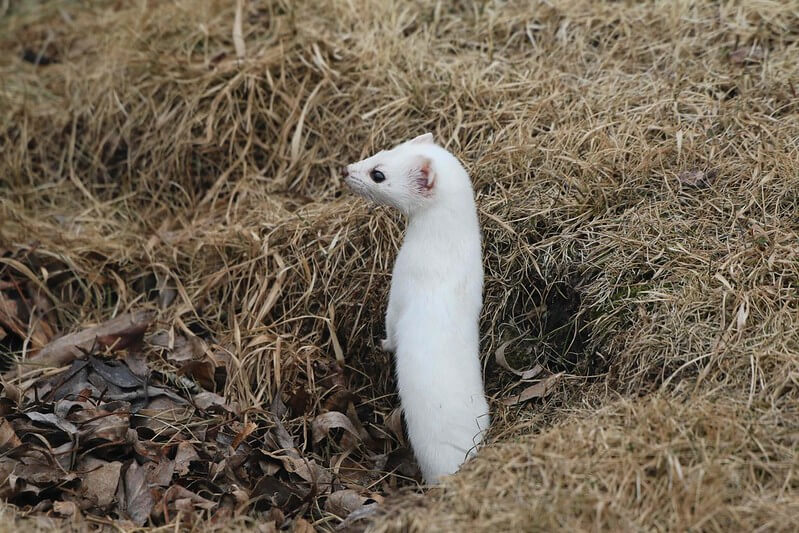Changing Daylight: How a Weasel Turns White
By Christine Wren
Broadcast 3.2009, 3.2012, 3.2016, 3.2019, 3.22 & 3.25.2023

Still arrayed in its winter white, an ermine stands out against the brown spring landscape. Photo by USFWS / Ann Hough, National Elk Refuge volunteer, CC by 2.0.
Listen:
Lately, I’ve been watching the sun, paying attention to its path across the foothill canyons near my home. As spring approaches, the sun’s arc rises a little higher each week, every day adding a few more minutes of daylight. Deep in the canyons, every minute of sunlight makes a difference. It also turns out that changing daylight is the answer to a question that’s needled me all winter long. That being…Just how does a weasel know when to change color?
I started pondering this question last fall during a hike along a small creek in the Bitterroot Mountains near the Montana / Idaho border. Late fall, but no snow on the ground—the first, real winter storm still two weeks away. Instead, a brown understory of rotting leaves, bare shrubs, and downed timber. Out of this earthy landscape a small, white shape caught my eye. Then it moved! A short-tailed weasel—called an ermine when winter white—tiny, but long, with its signature black-tipped tail. It skirted the creek bank, darting between bushes, and then amazingly moved toward me as it crossed a fallen log, spanning the creek. Mid-way across it stopped briefly, raised up on hind legs, eyes fixed in my direction. Just as quickly, it disappeared under a rotting wood cabin along the creek bank.
I was dumbfounded. Without the color contrast, I wouldn’t have seen it. The benefit of camouflage, and hazards without it, were clear. Ermine have the unique ability to change the color of their fur to match different seasonal environments. Switching from brown to white in winter, then back again to brown in spring, this animal specializes in surviving by blending into both landscapes. But why had it turned white prematurely, before the first snow arrived? Changing too soon, it’s easy prey for a fox. So just how does an ermine know when to change color?
The question lingered all winter, and then found an answer in changing sunlight patterns.
It’s not animal instinct or knowing, that determines physical and behavioral adaptations. Animals respond to seasonal change in a variety of ways in order to survive. Some hibernate, some migrate, some stick around and grow thicker fur. And a few special animals change the color of their fur or feathers to match changing camouflage needs.
Ermine, like ptarmigan and snowshoe hare, change color because of their unique physical reaction to the photoperiod, or length of daylight hours. For these animals, decreasing amounts of daylight in late fall trigger hormone reactions that cause changes in the production of natural pigments in their bodies. Reduced daylight causes a chemical reaction that decreases levels of dark, melanin pigments. As new fur or feathers grow in, a white coat gradually replaces the brown one. In spring, the reverse happens. Increased daylight hours cause dark pigment levels to rise, meaning brown fur starts to grow again. Temperature shifts play a role, but the amount of daylight is key to this amazing color transformation.
So, I need to retrace my footsteps along that creek this spring, keeping an eye out for a brown short-tailed weasel. Will the increased daylight coincide with a complete snowmelt? Maybe yes, maybe no. Snowfall patterns vary from year to year, but nature is constant in the time she keeps, in her annual cycles of darkness and light.
Every week since 1991, Field Notes has inquired about Montana’s natural history. Field Notes are written by naturalists, students, and listeners about the puzzle-tree bark, eagle talons, woolly aphids, and giant puffballs of Western, Central and Southwestern Montana and aired weekly on Montana Public Radio.
Click here to read and listen to more Field Notes. Field Notes is available as a podcast! Subscribe on Apple Podcasts or wherever you listen to podcasts.
Interested in writing a Field Note? Contact Allison De Jong, Field Notes editor, at adejong [at] montananaturalist [dot] org or 406.327.0405.
Want to learn more about our programs as well as fun natural history facts and seasonal phenology? Sign up for our e-newsletter! You can also become a member and get discounts on our programs as well as free reciprocal admission to 300+ science centers in North America!












